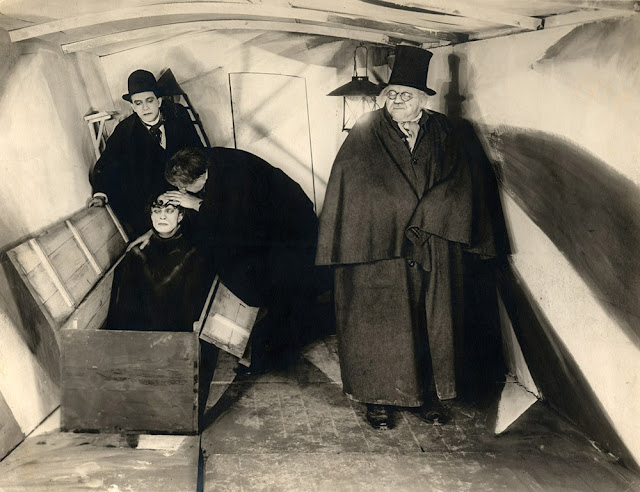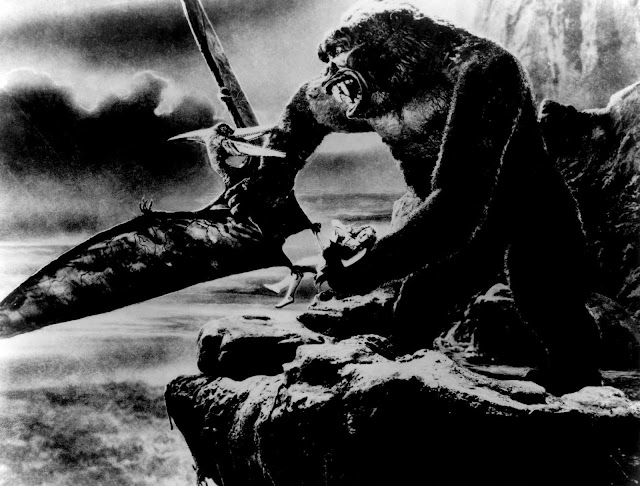The Cabinet of Dr. Caligari (1920)
Robert Wiene's "The Cabinet of Dr. Caligari"
Robert Wiene, a German film director from the silent era, created one of the most important works of cinematic art. The Cabinet of Dr. Caligari is widely regarded as a masterpiece of visual expression and psychological horror. The film explores themes of authority, fear, and the blurred boundaries between sanity and insanity. This haunting work would not only inspire the German Expressionist movement of the 1920s but also become inextricably linked to the fear and turmoil of the Weimar Republic.
The film was written by Hans Janowitz and Carl Mayer, who both harbored a deep distrust of authority following World War I. Janowitz, having served as an officer, became embittered by the experience and adopted pacifist views. Mayer, on the other hand, feigned insanity to avoid military service, which led to an intense examination from a psychiatrist - this psychiatrist would later serve as the template for the character of Dr. Caligari. The writing duo first conceived the story during a visit to a circus sideshow in Berlin. The attraction, called "Man or Machine?," featured a man performing various stunts and feats of strength after being hypnotized. Inspired by this display of hypnotic control, Janowitz and Mayer fused their experiences of deranged authoritarian figures to construct a premise in which power over the conscious mind becomes questioned.
The film opens with a man named Francis sitting on a bench, confiding in an older man that spirits have driven him away from his family and home. Just then, a dazed woman passes by, seemingly in a ghostly trance. Francis explains that the woman is his fiancée, who has endured a great ordeal. The rest of the film unfolds as a flashback, bringing Francis's recollections to life.
Francis and his friend Alan are both vying for the affection of Jane, so they take her to a town fair. There, they encounter a sideshow presented by a man named Dr. Caligari, who introduces a 'sleepwalker' named Cesare. Caligari claims that Cesare, when awakened, will obey any command. Not only that, Cesare can predict the past and the future. When Cesare is awakened, Alan approaches him and asks when he will die, to which Cesare ominously replies, "You will die at dawn." This premonition turns out to be true when the police discover Alan's lifeless body, murdered in his home.
Convinced that Caligari or Cesare is involved in Alan's death, Francis begins to spy on them. However, Caligari presents a doll of Cesare as a prop, while the real Cesare goes out to murder Lucy. The attempt is unsuccessful, and Cesare runs off, only to be chased by an angry mob and eventually die.
Francis uncovers Caligari's deception and pursues him to a nearby insane asylum, only to learn that Caligari is the asylum's director. When Francis and the other doctors confront him, Caligari spirals into madness and is restrained. He then becomes a patient in his own asylum. As the film returns to the present, it is revealed that Francis is actually a patient in the asylum, believing that Caligari has lured him there and trapped him.
Hermann Warm, the designer of the film's sets, believed that naturalism was ill-suited for the film's subject matter. Instead, he proposed a graphic, fantastical style, one that would present visionary, nightmarish images that deviated from the ordinary. He envisioned an expressionist aesthetic, akin to a painting, and suggested painting forms and shadows directly onto sets would achieve a dark and surreal look.
Wiene accepted these visual ideas not for any artistic reasons, but because Expressionism was a fashionable art form at the time, which he believed would add to the commercial viability of the film. Additionally, the painted canvases as scenery, with paper as its construction material, proved enormously inexpensive. This was especially crucial given the economic challenges of the time, such as inflation and currency devaluation, which forced German film studios to seek more affordable production methods.
The film was shot entirely in studio without any exterior shots. This was considered unusual for the time, but Wiene felt this enabled the film's expressionist visual style. The relatively small size of the studio required sets not to exceed six meters in width and diameter. Because of this, the camerawork is fairly simple, alternating between medium shots and straight-on angles, with the occasional abrupt close-up to create a sense of shock. Editing is also sparse, as most scenes follow others without intercutting. This gives the film more of a theatrical vibe, rather than cinematic. Heavy lighting is also used sparingly, which amplifies the darkness in the frames. Lighting is, however, used to create visual distortions and cast shadows.
The visual style of the film creates a dark, radical expression of its unsettling themes. The deliberate distortions in perspective, form, dimension, and scale creates a topsy-turvy and unbalanced appearance. The sets are full of sharp, pointed forms that extend from curving lines, full of both narrow and spiraling streets. This, combined with the landscapes that balance at unusual angles, creates the impression of a paradoxical and disordered world, always teetering on the brink of collapse.
Black paint was applied to large canvases instead of constructing traditional sets. Shadows and streaks of light were also painted directly onto the set, further distorting perception and dimension. Real-world objects were intentionally distorted, such as windows with uneven frames, doors that were not rectangular, chairs that were too tall, and trees with twisted branches. This warped reality heightens a sense of anxiety and terror in the viewer. The world depicted is a nightmare, transformed by evil. Once it's revealed in the end that our story is the mental breakdown of an unreliable and unstable narrator, the distorted reality is revealed to be a manifestation of his inner turmoil.. With this, the birth of Expressionist Cinema is realized. The visual style of Expressionism, beginning with The Cabinet of Dr. Caligari, represents an emotional state rather than an objective reality.
Many viewed the film as a representation of Germany during the war. The character of Caligari represents the tyrannical German government, while Cesare represents the "common man of conditional obedience." Just like with soldiers in the war, Caligari instructs the sleepwalking Cesare to "kill or be killed," and enact his ultimate whim. The control Caligari yields over Cesare and others creates this sense of moral perversion. In his book, "From Caligari to Hitler," Siegfried Kracauer argues that the existence of the characters represents Germany's "collective soul." He feels that Caligari and Cesare are premonitions of Adolf Hitler's rule over Germany, and that his control over the weak-willed, puppet-like somnambulist prefigures aspects of the mentality that allowed the Nazi party to rise. He calls Caligari's use of hypnotism to impose his will a foreshadowing of Hitler's "manipulation of the soul." He also interprets the film as a commentary on Germany’s obedience to authority and the failure—or unwillingness—to rebel against deranged power, reflecting a "general retreat" in post-war Germany. Cesare represents this collective retreat into a sleepwalking state, enacting out weak-willed obedience. Like Caligari, the film is full of tyrannical control. Authorities sit atop high perches above the people they deal with and hold offices out of sight at the end of long, foreboding stairways. There are other authority figures like authoritarian police and bureaucrats. These characters represent rigid control. Chaos, on the other hand, is represented through the crowds of people, like at the town fair, or the paranoid crowds full of fear over the murders as they inhabit this nightmare world. Kracauer argues that there is no middle ground between the two extremes of control and chaos in the film, forcing the characters and the viewer to embrace either insanity or authoritarianism, leaving no room for actual human freedom. As he writes, "[The Cabinet of Dr.] Caligari exposes the soul wavering between tyranny and chaos, and facing a desperate situation: any escape from tyranny seems to throw it into a state of confusion."
In the final scene, the film itself embodies ultimate authority, revealing that what we, as viewers, have just witnessed is a delusion. It exposes the fallibility of our own human perceptions. Much like Caligari manipulating the unconscious mind of the sleepwalker, the film does the same to us. It challenges the images we have been associating with reality, suggesting that they may be entirely false. Just as Francis’s understanding of events is ultimately questioned, so too are our perceptions of the story. Are we, in fact, the sleepwalkers? An authoritative figure—the film itself—has presented a seemingly truthful reality, leading us to believe in its objective truth. Yet, with the final twist, this truth is shattered, forcing us to reconsider the authority that shaped it. The film highlights the ease with which our subjective realities can be corrupted and manipulated. Like the sleepwalker, we too have fallen under a hypnotic spell, led to accept a fabricated reality.
Due to the intentional confusion at the end, it becomes difficult to discern who is truly insane or trustworthy. Is Francis an unreliable narrator, or is he justified in believing that Caligari has orchestrated his doomed fate, placing him under ultimate control? This ambiguity regarding what is real and who is sane forces us to question the very nature of truth in reality itself. As historian Stephen Brockman puts it, "In the end, the film is not just about one unfortunate madman; it is about an entire world that is possibly out of balance."
Vincent LoBrutto suggests that the film can be interpreted as a social or political analogy for "the moral and physical breakdown of Germany at the time." This collapse of moral stability and questions of sanity contribute to the Cesare-like sleepwalking effects on citizens. The collective fear and trauma of the nation would later manifest in what Sigmund Freud would call the longing for protection by a tyrannical father figure, or what Kracauer identified as "asocial authority." In combination with the film's exploration of how easily our perceptions can be manipulated, The Cabinet of Dr. Caligari emerges as a work of art with lasting significance. In hindsight, many regard it as the first horror film, illustrating the human desire for conditioned security to counter chaos and confusion. This conditioning creates the sleepwalking puppet—an individual willing to sink into moral corruption as an antidote to disorder and death.







Comments
Post a Comment